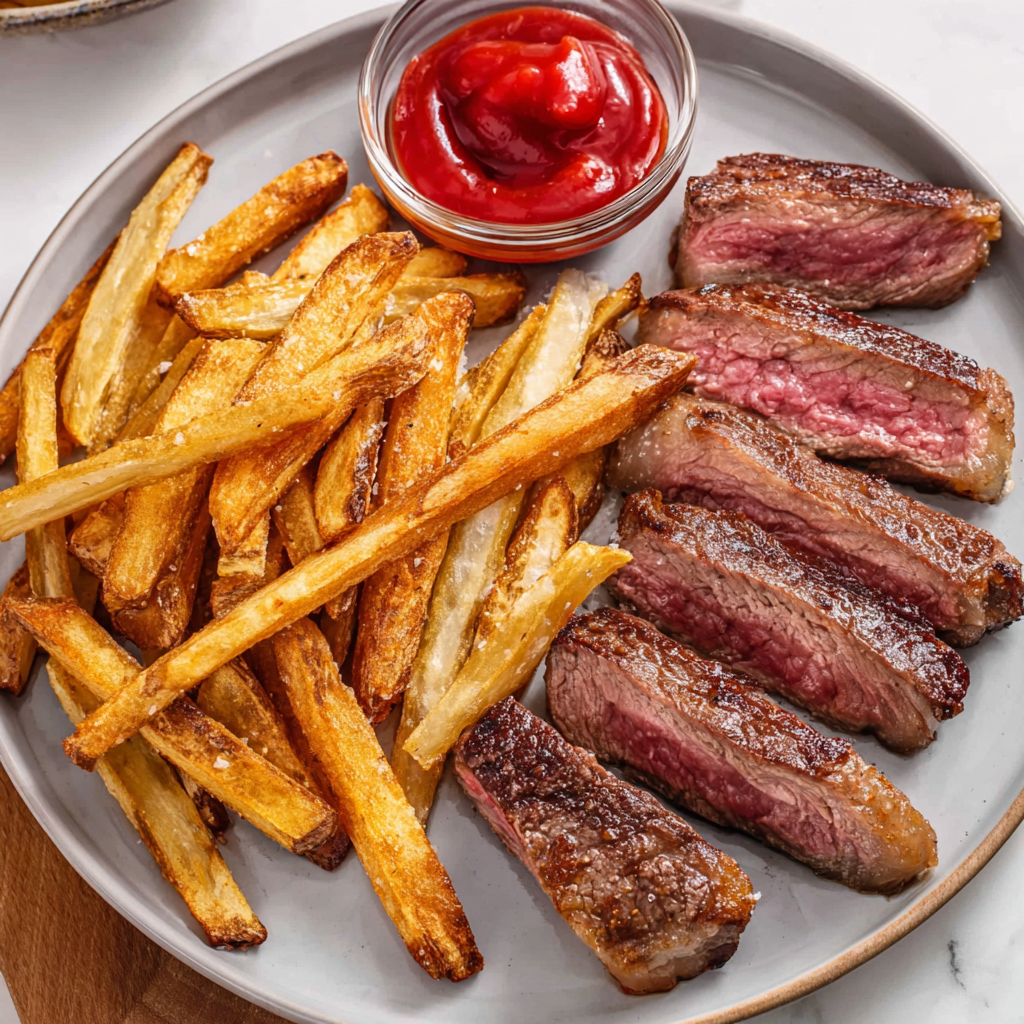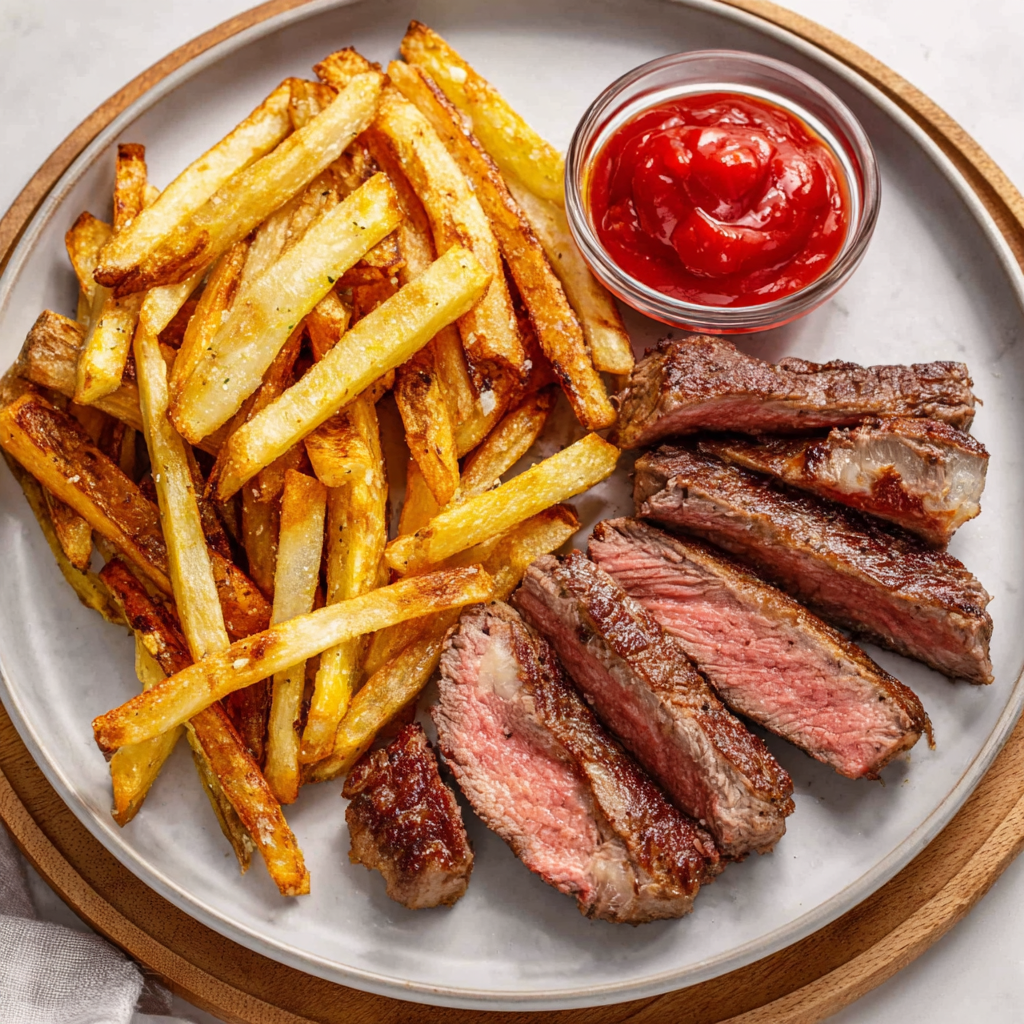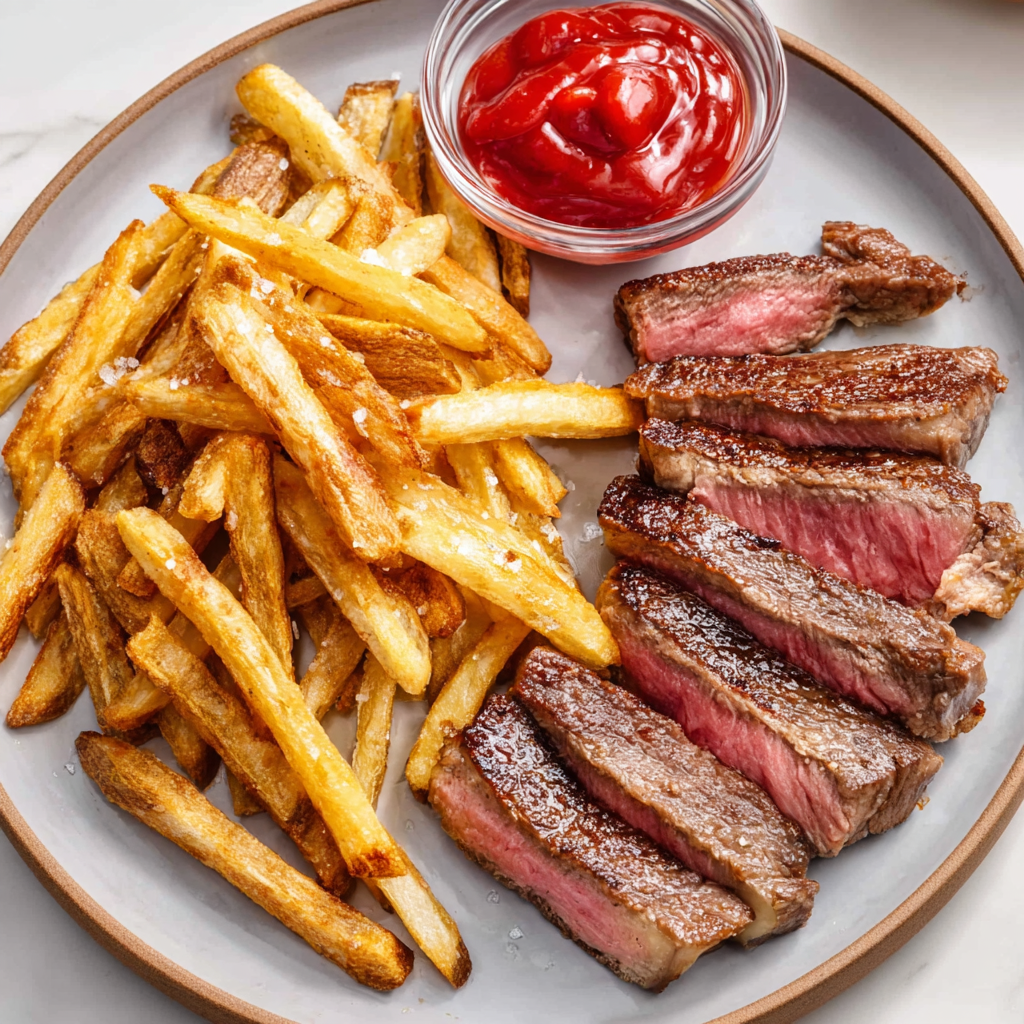1. Introduction to the Recipe
There are few dishes as iconic, comforting, and universally loved as Steak Frites. This timeless French bistro meal features two beautifully simple components—crispy, golden fries and a juicy, perfectly seared steak. Though the ingredients are minimal, the magic lies in the technique: soaking potatoes in ice water for maximum crispness, double-frying them to create the ideal texture, and cooking a buttery, seasoned ribeye to rich, tender perfection. The contrast of hot, crunchy fries next to a deeply flavored steak makes Steak Frites a standout choice for at-home date nights, elegant dinners, or elevated weekend cooking.
What makes this dish so appealing is its incredible balance between simplicity and satisfaction. You don’t need a long ingredient list or advanced cooking skills—you just need patience, heat control, and a willingness to trust the process. The crispy fries come from the classic method used in restaurants worldwide: rinsing off excess starch, blanching at a lower temperature, then frying again at a higher heat. Meanwhile, the ribeye steak is seared in butter until perfectly browned, juicy, and tender. This method is long loved because it works every single time.
If you’re interested in the science of crispiness, you might enjoy reading resources like why soaking potatoes improves texture or exploring ideas from classic French bistro cooking techniques. These principles help explain why Steak Frites has remained a beloved favorite for generations and how small details elevate a simple dish into something extraordinary.
With its rich flavor, irresistible textures, and restaurant-quality results, Steak Frites is a must-have recipe in any home cook’s rotation. The combination of crispy potatoes and a tender ribeye is timeless, comforting, and endlessly impressive—proving that great cooking doesn’t need to be complicated to feel luxurious.
2. Basic Recipe: Ingredients and Instructions
Print
Steak Frites: Classic Crispy Fries and Juicy Ribeye
Description
Classic Steak Frites with crispy double-fried potatoes and buttery ribeye. A bistro-style favorite you can recreate at home.
Ingredients
Fries
- Ice (for soaking potatoes)
- 3 pounds Russet potatoes (about 3 large)
- Canola, vegetable, or peanut oil for frying
- 1 teaspoon salt
Steak
- 1 pound ribeye steak (or one steak per person)
- 1 teaspoon salt
- 3 tablespoons unsalted butter, divided
- Flaky sea salt for garnish
Instructions
For the Fries
- Prepare the Potatoes
Peel (optional) and cut potatoes into ¼-inch thick sticks. Rinse under cold water until the water runs clear. - Soak in Ice Water
Place cut potatoes in a bowl filled with ice and cold water. Soak for at least 30 minutes, preferably 1–2 hours for best crispness. - Heat the Oil for Blanching
Heat oil in a deep pot or fryer to 300°F (150°C). - Blanch the Fries
Dry potatoes thoroughly. Fry in batches for 5–6 minutes until pale and soft but not brown. Drain on a wire rack. - Increase Oil Temperature
Heat the oil to 375°F (190°C) for the final fry. - Crisp the Fries
Fry blanched potatoes again for 3–4 minutes until golden brown and crisp. Drain and immediately season with salt.
For the Steak
- Season the Steak
Pat dry and season with 1 teaspoon salt. Let sit at room temperature for 20–30 minutes. - Heat the Skillet
Heat 1 tablespoon butter in a heavy skillet over medium-high heat. - Sear the Steak
Add steak and sear 3–5 minutes per side until browned. Add remaining butter and baste the steak while cooking. - Check Doneness
Cook to preferred temperature (130°F for medium-rare). - Rest and Serve
Rest steak for 5 minutes. Slice, top with flaky sea salt, and serve with fries.
Notes
Russet potatoes are essential for achieving the perfect fry texture.
Dry potatoes thoroughly before frying—moisture causes soggy fries and hot oil splatter.
Basting the ribeye with butter enriches flavor and improves crust formation.
Always rest steak before slicing to retain juices.
3. Advanced Techniques
1. Perfecting Double-Fried Potatoes for Maximum Crispiness
Double-frying is at the heart of great Steak Frites, but mastering the temperatures and timing is what takes fries from good to exceptional. The first fry at 300°F gently cooks the potatoes and removes internal moisture without browning. This sets up the interior to become soft and fluffy. After resting, the second fry at 375°F rapidly crisps the outside, creating a shattering crust that stays crisp even as the fries cool. Ensuring the oil maintains consistent temperature is crucial—crowding the pot or using insufficient oil leads to soggy fries. Using a wire rack instead of paper towels also prevents steam from softening the crust.
2. Choosing the Right Cut and Marbling for Superior Steak Flavor
Ribeye is the traditional choice for Steak Frites due to its rich marbling, which melts during cooking and creates exceptional tenderness. However, all ribeyes are not equal. Look for steaks with even marbling throughout, not just a large central fat eye. Marbling allows the steak to self-baste as it cooks, resulting in a deeper beef flavor and juicier texture. Bringing the steak to room temperature before cooking helps achieve an even sear, while patting it dry ensures maximum crust formation. With a quality cut and proper preparation, the steak becomes as memorable as the fries.
3. Basting with Butter for a Restaurant-Quality Crust
Professional kitchens often rely on butter-basting to achieve the signature golden crust and rich flavor in their steak. Once the steak is seared on both sides, adding butter and tilting the pan allows you to spoon the foamy, aromatic butter over the steak repeatedly. This technique bastes the surface while promoting deeper browning and flavor. You can elevate the butter by adding thyme, rosemary, or crushed garlic to create a French bistro–style aroma. Butter-basting should be done during the final minutes of cooking to prevent burning.
4. How to Control Heat for the Perfect Steak Sear
Heat control is one of the most important skills for perfect Steak Frites. The skillet must be hot enough to create a deep brown crust, but not so hot that the butter burns. Begin with high heat using a neutral oil to establish the initial sear, then add butter once the crust forms. Reducing heat slightly during basting prevents scorching. Avoid flipping the steak repeatedly—letting it sit undisturbed encourages even browning. Mastering heat control ensures juiciness while delivering a restaurant-quality crust every time.
5. Achieving Even Fry Texture Through Proper Potato Preparation
The difference between average fries and outstanding Steak Frites fries often comes down to how the potatoes are prepared before frying. Soaking cut potatoes in ice water removes excess surface starch, which reduces browning too early and creates sogginess. Using ice-cold water tightens the potato structure, leading to a firmer interior that contrasts beautifully with the crispy exterior after frying. Drying the potatoes fully is equally important—residual water turns to steam and disrupts browning. This simple preparation step dramatically improves texture and consistency.

4. Storage, Shelf Life, and Maintenance Tips
1. Storing Leftover Fries Without Losing Crispiness
Fries are best fresh, but Steak Frites leftovers can still be enjoyable if stored properly. After cooling on a rack, store fries uncovered in the refrigerator for 1–2 hours to allow moisture to escape. Then transfer to an airtight container for up to 3 days. The best reheating method is an air fryer at 375°F for 4–6 minutes, which revives crispiness far better than microwaving. An oven at 425°F also works when spread out on a rack.
2. How to Store Leftover Steak for Optimal Texture
Leftover steak keeps for 3–4 days when stored in an airtight container. For the best eating experience, reheat gently. Avoid microwaves, which toughen the meat. Instead, warm slices in a covered skillet with a tablespoon of water or broth on low heat for 3–4 minutes. Alternatively, place the steak in a zip-top bag and submerge in warm water (not hot) for a gentle sous-vide-style reheat that preserves tenderness.
3. Freezing Components Separately for Long-Term Storage
While fries do not freeze well once cooked, blanched potatoes freeze beautifully. After the first fry, cool completely and freeze in a single layer. Store up to 2 months, then fry directly from frozen. Steak can also be frozen raw or cooked. Wrap tightly in plastic and foil to prevent freezer burn. This setup allows you to enjoy fresh Steak Frites with minimal prep.
4. Maintaining Fry Quality During Meal Service
To keep fries crisp while preparing the steak, place them on a wire rack in a warm oven at 250°F. Avoid stacking them, which traps steam. This method maintains crispness without overcooking. For steak, keep it tented loosely with foil if resting for extended periods, ensuring juices redistribute while staying warm.
5. Restoring Leftover Steak Frites into New Dishes
Leftovers can be repurposed into gourmet meals. Slice leftover steak thinly and add to salads, sandwiches, rice bowls, or breakfast hash. Re-crisp fries in an air fryer and use them as the base for poutine, loaded fries, or skillet breakfasts. These transformations give leftovers new life and prevent waste.

5. Dietary Adaptations and Substitutions
1. Gluten-Free Adaptation
This recipe is naturally gluten-free as long as your ingredients—especially salt, butter, and seasonings—are certified gluten-free. Some frying oils may include additives, so check labels. Serve with gluten-free sauces such as aioli or mustard. If making fries ahead, ensure freezing bags or storage containers are contamination-free.
2. Lower-Fat or Health-Conscious Version
For a lighter version, oven-bake the fries at 450°F for 25–35 minutes, flipping halfway. They won’t be identical to double-fried potatoes but still become beautifully crisp. Choose a leaner steak cut like sirloin or strip loin. Use 1–2 tablespoons butter instead of 3 and supplement flavor with herbs or garlic.
3. Dairy-Free Adaptation
Replace butter with a high-quality dairy-free butter or use olive oil for basting. Some plant-based butters brown similarly to dairy butter, enhancing color and flavor of the steak. Choose a steak with good marbling to maintain juiciness without relying on dairy.
4. Vegetarian Version
For vegetarian diners, the fries remain the same, but substitute the steak with grilled portobello mushrooms, marinated tofu steaks, or seared cauliflower steaks. Baste with butter or vegan butter for richness. These options pair beautifully with the fries and maintain the spirit of the dish.
5. Low-Sodium Approach
Reduce salt on both steak and fries. Use unsalted butter and season with herbs like thyme, cracked pepper, or garlic instead. Avoid flaky sea salt garnish or use sparingly. Flavor enhancement can still be achieved through browned butter and aromatics.

6. FAQs About the Recipe
1. Why do the potatoes need to be soaked in ice water?
Soaking potatoes in ice water removes excess starch and firms up the potato structure. This prevents premature browning and allows the fries to become crisp on the outside while staying tender inside. Cold temperatures also help achieve straighter, cleaner fry cuts that hold their shape during cooking. Without soaking, potatoes tend to soften unevenly, absorb more oil, and become soggy quickly.
2. Can I use a different potato variety?
Russet potatoes are ideal due to their high starch and low moisture content. Waxy potatoes like Yukon Gold produce softer fries that do not crisp as well, though they are still delicious. For classic Steak Frites texture, Russet is strongly recommended.
3. How do I know when my steak is cooked to the right doneness?
Using a meat thermometer ensures accuracy. For medium-rare (the classic Steak Frites doneness), aim for 130°F after resting. Searing time varies based on steak thickness, pan heat, and marbling. Pressing the steak gently can also help—you’re looking for a soft but springy feel for medium-rare.
4. What oil is best for frying the potatoes?
Use oils with high smoke points such as peanut, canola, or vegetable oil. Peanut oil produces exceptional crispness and flavor but may not be suitable for allergies. Avoid olive oil, which smokes at a lower temperature and affects taste.
5. Can I cook the steak and fries simultaneously?
Yes, but plan the workflow carefully. Make the fries first, keep them warm on a rack in the oven, and cook the steak last to ensure it stays juicy and hot. Alternatively, prepare the steak first and crisp the fries right before serving. Both methods deliver excellent results if timing is managed well.

7. Conclusion & Final Thoughts
Steak Frites is a timeless example of how simple ingredients can create a meal that feels deeply satisfying, luxurious, and comforting all at once. This classic combination of crispy double-fried potatoes and rich, buttery ribeye steak showcases the beauty of technique-driven cooking. With just a handful of ingredients—potatoes, oil, salt, steak, and butter—you can create a restaurant-quality dish that looks and tastes like something straight from a French bistro.
One of the reasons Steak Frites remains so beloved is its versatility. You can dress it up with garlic herb butter, sauces like béarnaise or peppercorn, or keep it beautifully simple with a sprinkle of flaky salt. The fries can be seasoned in countless ways, from garlic parmesan to truffle salt, and the steak can be cooked rare or well-done depending on preference. Every variation retains the heart of what makes the dish special: balance, contrast, and texture.
Beyond its flavor, this recipe is a celebration of technique—soaking, blanching, double-frying, basting, resting. These small steps come together to form a meal that feels impressive without being overly complicated. It’s the kind of recipe that turns an ordinary evening into something memorable and turns simple ingredients into something crave-worthy.
Whether you’re cooking to impress, preparing a date-night dinner, or simply indulging in the comfort of a classic, Steak Frites offers a perfect blend of crispiness, juiciness, and elegance. With practice and patience, you’ll find yourself making this dish again and again, mastering each step and enjoying a timeless favorite in your own kitchen.
